Highlights
What are the main findings?
- A density-based Freeze–Thaw Disturbance Index (FTDI) was proposed to quantify the spatial clustering of disturbance features.
- Higher FTDI values indicate a greater likelihood of surface thawing processes triggered by rising temperatures.
What are the implications of the main findings?
- Regions with relatively high FTDI values often contain substantial amounts of organic carbon and may experience delayed vegetation green-up despite general warming trends.
- FTDI reflects the impact of potential freeze–thaw dynamic phase changes on the geomorphology and offers a new perspective for monitoring permafrost degradation.
Abstract
The soil freeze–thaw process is a dominant disturbance in the seasonally frozen ground and the active layer of permafrost, which plays a crucial role in the surface energy balance, water cycle, and carbon exchange and has a pronounced influence on vegetation phenology. This study proposes a novel density-based Freeze–Thaw Disturbance Index (FTDI) based on the identification of the freeze–thaw disturbance region (FTDR) over the Qinghai–Tibet Plateau (QTP). FTDI is defined as an areal density metric based on geomorphic disturbances, i.e., the proportion of FTDRs within a given region, with higher values indicating greater areal densities of disturbance. As a measure of landform clustering, FTDI complements existing freeze–thaw process indicators and provides a means to assess the geomorphic impacts of climate-driven freeze–thaw changes during permafrost degradation. The main conclusions are as follows: the FTDR results that are identified by the random forest model are reliable and highly consistent with ground observations; the FTDRs cover 8.85% of the total area of the QTP, and mainly in the central and eastern regions, characterized by prolonged freezing durations and the average annual ground temperature (MAGT) is close to 0 °C, making the soil in these regions highly susceptible to warming-induced disturbances. Most of the plateau exhibits low or negligible FTDI values. As a geomorphic indicator, FTDI reflects the impact of potential freeze–thaw dynamic phase changes on the surface. Higher FTDI values indicate a greater likelihood of surface thawing processes triggered by rising temperatures, which impact surface processes. Regions with relatively high FTDI values often contain substantial amounts of organic carbon, and may experience delayed vegetation green-up despite general warming trends. This study introduces the FTDI derived from the FTDR as a novel index, offering fresh insights into the study of freeze–thaw processes in the context of climate change.
1. Introduction
The soil freeze–thaw process is the primary process and one of the main disturbance factors in the seasonally frozen ground (SFG) and the active layer of permafrost; this process plays a crucial role in the surface energy balance, water cycle, and carbon exchange and has a pronounced influence on vegetation phenology [,,,,,]. In the soil freeze–thaw process, periodic frost heaving and thawing can directly or indirectly alter landform characteristics [,], ultimately leading to the development of thermokarst. Therefore, exploring the soil disturbances caused by the freeze–thaw process from the perspective of the distribution of thermokarst landforms can provide a new perspective for quantifying freeze–thaw processes.
Thermokarst landforms are widely developed in permafrost regions around the circumpolar Arctic, and global warming is accelerating their formation. Between 1984 and 2015, particularly after warm summers, more than 4000 retrogressive thaw slumps (RTS) developed in the Banks Island region of Canada, representing a nearly 60-fold increase compared with that in 1984 []. In the context of global warming, as the permafrost degrades, the soil freeze–thaw process has changed, and thermokarst landforms are developing rapidly in permafrost regions [,]. Research shows that the development of thermokarst landforms affects carbon release and vegetation growth, rendering the carbon cycle in permafrost regions highly uncertain [,]. Specifically, during the development of thermokarst landforms, complex and dynamic microtopography occurs, which changes the hydrothermal conditions of the soil []; these changes, which occur under original soil environmental conditions, have a successively significant effect on vegetation growth [,], soil organic carbon (SOC) storage [], and CO2 and CH4 releases in the soil [,,,]. However, determining how the changes in soil organic carbon and vegetation phenology respond to or are related to soil freeze–thaw disturbances at the landscape scale is challenging []. Quantitatively evaluating the degree of disturbance in thermokarst landforms and revealing the relationships among the remaining freeze–thaw processes is important but remains a significant challenge.
Currently, remote sensing datasets are widely used to study the distributions and impacts of thermokarst landforms in the Arctic at small regional scales [,,,]. For example, the rapid development of thermokarst landforms has been observed in northwest Alaska through the combination of synthetic aperture RADAR and optical imagery []; moreover, aerial photographs [,,] have also been used to examine thermokarst landforms. With the continuous expansion of the research area, large-scale and continuous optical satellite image data are also being gradually applied in the analysis of thermokarst landforms, providing a good data source for understanding the distribution of thermokarst landforms at large scales. For example, in the Richardson Mountains-Peel Plateau region of the Northwest Territories, Canada [], northwestern Alaska [], and northern Siberia [], Landsat (30 m) and Sentinel-2 (10 m) images have been successfully applied to identify and monitor thermokarst landforms.
As the highest permafrost area in the world, the Qinghai–Tibet Plateau (QTP) encompasses a permafrost area of 1.06 × 106 km2 and a seasonally frozen soil area of 1.46 × 106 km2, which has a significant impact on global climate change []. Like other permafrost zones around the globe, the permafrost zone on the QTP is experiencing significant degradation due to increasing temperatures, which has led to the rapid development of thermokarst landforms in this region. The earliest discovered thermokarst landforms are RTS located in the Fenghuo region of the QTP []. Since then, an increasing number of thermokarst landscapes have been discovered and have attracted widespread attention. In recent years, high-resolution satellite images and observation techniques, such as unmanned aerial vehicles (UAVs), have enabled the effective monitoring of thermokarst landforms. Several permafrost collapses have been successfully detected in areas such as the Beilu River and Ebeling of the Qilian Mountains, and expansions of thermokarst areas have also been observed [,]. Moreover, deep learning methods have also been applied to satellite images to identify RTSs. For example, Huang et al. [,] successfully applied DeepLabv3+ to monitor the distribution and development of RTSs in the Beilu River area of the QTP. A total of 220 RTS were identified and mapped, with the majority located in lowland areas with gentle slopes, and most were expanding []. In addition, datasets of thermokarst landforms of the QTP, such as thermokarst lakes, RTS, and hillslope thermokarst datasets, have been published [,,], generated, and applied to a wide range of diverse applications [].
Although regional-scale thermokarst data can help us better understand the distribution of thermokarst landforms and evaluate the impacts of freeze–thaw processes, most current studies have focused primarily on the distribution and morphological development of thermokarst landforms in small areas. Unfortunately, most of the released thermokarst datasets are often inapplicable when used to assess freeze–thaw processes. Among them, thermokarst lakes primarily exist in the form of water bodies after formation, and freeze–thaw processes manifest as freezing and melting of the water, with less evident disturbance to the soil. On the other hand, thaw slumps, interpreted through visual analysis, are often based on the distribution of permafrost. These slumps tend to occur in the western part of the QTP, where the permafrost is relatively stable (Figure 1) and the soil moisture (SM) content is relatively low, which may not effectively reflect the changes in freeze–thaw processes.
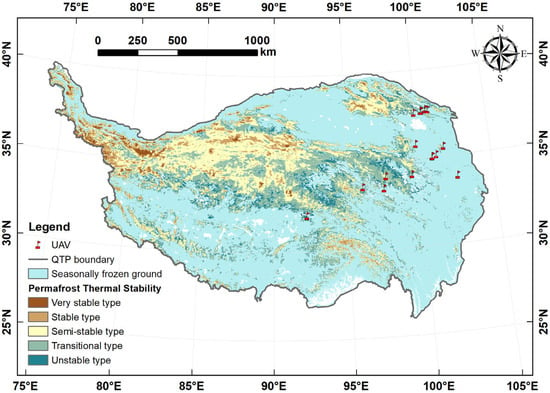
Figure 1.
Distribution of permafrost thermal stability types and seasonally frozen ground on the QTP. The red flags indicate the UAV image collection sites.
Existing freeze–thaw indices are generally derived from process-based thermal metrics, such as the number of freeze–thaw days—the frequency of surface state changes—or the active layer thickness, which measures subsurface thaw depth. While these indices are essential for characterizing thermal dynamics, they do not directly capture the geomorphic consequences of freeze–thaw activity at the landscape scale. To address this gap, a new index, the density-based soil freeze–thaw disturbance index (FTDI), is proposed in this study on the basis of identification of the freeze–thaw disturbance region (FTDR) over the QTP. Specifically, FTDI is defined as an areal density metric based on geomorphic disturbances, i.e., the proportion of FTDRs within a given region, with higher values indicating greater areal densities of disturbance. FTDRs are recognized as thermal erosion gullies (TEG) and their surrounding areas. Then, by assuming that the larger the proportion of FTDRs in a particular region is, the higher the FTDI of that region is, and the corresponding FTDI can be calculated. FTDI captures the spatial distribution density of surface freeze–thaw disturbances, provides a potential link between geomorphic changes and permafrost degradation, and serves as a complement to conventional process-based parameters. Furthermore, the significance of the FTDI for variations in soil organic carbon and vegetation phenology is discussed by examining the relationships between the FTDI and variations in SOC and vegetation phenology. Section 2 introduces the study area, satellite imagery data, sample data, UAV image data, and other auxiliary datasets used in this study. Section 3 reviews the RF model and spectral indices and briefly introduces the accuracy assessment method using UAV images. The classification accuracy of FTDRs, the distribution of the FTDI, and a discussion on the indicative significance of the FTDI for changes in SOC stocks and vegetation phenology variations over the QTP are presented in Section 4, followed by conclusions in Section 5.
2. Study Area and Materials
2.1. Study Area
The QTP is located between 70–104.5°E and 25–40°N (Figure 1), with an average elevation of over 4000 m and complex terrain. The mean annual air temperature ranges from −3.1 °C to 4.4 °C. The average annual precipitation ranges from 103 mm to 694 mm, with the majority occurring during June and September []. Approximately 1.06 × 106 km2 of permafrost and 1.46 × 106 km2 of SFG exist on the QTP []. Ran et al. [] mapped permafrost stability on the QTP into unstable (20.1%), transitional (35.8%), semi-stable (32.8%), stable (9.4%), and very stable (1.9%) types according to their thermal stability, i.e., the multi-year average ground temperature (MAGT), as shown in Figure 1. Permafrost has a subsurface ice content of approximately 1.27 × 104 km3 water equivalent [,]. The average thickness of the permafrost active layer is approximately 2.0 m, ranging from 0.9 m to 3.2 m []. The vegetation cover types in the permafrost zone are dominated by alpine swamp meadows, alpine meadows, alpine grasslands, and alpine deserts []. Since the 1960s, the average annual temperature of the QTP has increased by 0.3 °C to 0.4 °C per decade, which is more than twice the global average [,]. The increasing temperature accelerated the degradation of permafrost. As the main feature of permafrost degradation, the rate of change for the thickness of the active layer is 3.6 cm yr−1 [].
2.2. Data Resources
2.2.1. Satellite Imagery
The Sentinel-2 satellite data are used as the primary satellite data to identify the distribution of the FTDR in this study. The Sentinel-2 mission consists of Sentinel-2A and Sentinel-2B, which are Earth observation satellites launched by the European Space Agency (ESA) in 2015, designed for monitoring vegetation, soil, and water bodies [,]. The onboard multispectral instruments can acquire reflectances over 13 spectral bands, covering visible (VIS), near-infrared (NIR), and shortwave infrared (SWIR) bands, with a revisit period of approximately five days. These instruments can provide images with spatial resolutions of 10 m, 20 m, and 60 m. We utilized the Sentinel-2 satellite surface reflectance dataset, COPERNICUS/S2_SR, provided by the ESA on the Google Earth Engine (GEE) platform, covering the growing season from May to October 2020. Image preprocessing, such as cloud removal, stitching, and subsequent classification, is implemented via the GEE platform, which is an advanced remote sensing cloud computing platform that supports a wide range of remote sensing data and has advanced computing capabilities, to analyze a large amount of remote sensing data in a short period []. This platform has been widely used in large-scale land object classification, water monitoring, and other research fields [,,,,,].
2.2.2. Validation Data
- UAV image data
To verify the classification accuracy of the RF-derived FTDR, field surveys were conducted from 2019 to 2022. A total of 17 UAV images, including those of typical FTDRs with very high spatial resolution (generally below 10 cm), were acquired by a DJI Mavic 2 Pro (DJI, Shenzhen, China) during the surveys and processed by DJI Terra software (Version 3.6.0). The collection sites for the UAV images are shown in Figure 1, and Table 1 lists the basic information for each UAV image collection site. The FTDRs within the high-resolution UAV images were identified through indoor visual interpretation, enabling a more detailed understanding of their distribution. The classified UAV images were then used to validate the RF-derived FTDRs.

Table 1.
Basic information for each UAV image collection site.
Figure 2 shows an example of an FTDR near the Qilian Mountains on the northeastern QTP (QL1). Figure 2a presents the distribution of FTDRs based on high-resolution imagery from Google Earth. Figure 2b shows the UAV imagery of a typical TEG feature within the corresponding FTDR. Figure 2(b1–b3) shows the corresponding photographs of the collapsed edges of the TEG labeled in Figure 2b.
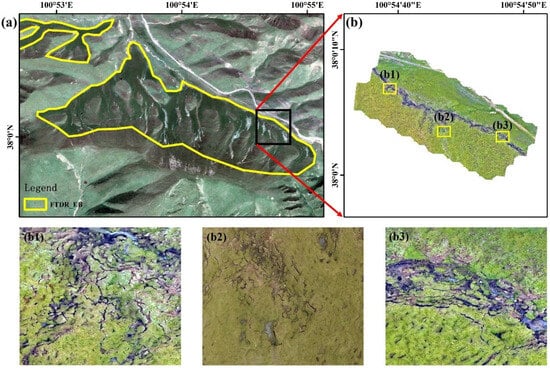
Figure 2.
(a) Google Earth image of the FTDR distribution area, (b) UAV image of a TEG with (b1–b3) representing the aerial images of three collapse locations caused by freeze–thaw disturbances.
- 2.
- Hillslope thermokarst dataset
The hillslope thermokarst dataset [] is the first of its kind to focus on thermokarst landforms in the Qinghai–Tibet Plateau. It encompasses features of TEG and RTS landforms from multiple periods (1999–2023) in the Qilian Mountains, with a total of 2717 features across all periods. The datasets were obtained through manual visual interpretations of high-resolution satellite imagery, and their reliability was verified through field validations. This dataset provides an important reference for the large-scale mapping of thermokarst landforms and was therefore utilized to validate the reliability of the results in this study.
To facilitate the validation, features from different periods were integrated to generate independent maps for each landform, comprising 545 features from RTSs and 522 features from TEGs, totaling 1064 features. Furthermore, on the basis of the RTS characteristics analyzed in the introduction, they were excluded from the validation. This resulted in a final count of 522 TEG features ready for validation, which are considered to correspond to the definition of the FTDR.
2.2.3. Auxiliary Data
The Digital Elevation Model (DEM) data used in this study consist of Shuttle Radar Topography Mission (SRTM) terrain data (CGIAR/SRTM90_V4) with a 90 m resolution provided by NASA on the GEE platform. The DEM and corresponding slope data are used as classification features in the RF-based FTDR classification procedure. The DEM data are also used to determine the FTDR distribution characteristics as the altitude changes. The permafrost distribution data [] and permafrost stability data [] for the QTP were obtained from the Qinghai–Tibet Plateau Data Center []. They are also used to analyze the characteristics of the FTDR distribution over different permafrost types with different thermal stabilities. The ERA5-Land soil moisture (0–7 cm, 2001–2020) product with a spatial resolution of 0.1° is used to analyze the soil moisture distribution within the FTDR. ERA5-Land shallow soil temperatures (0–7 cm, 2001–2020) were used to calculate different soil freeze–thaw factors to analyze the FTDI. ERA5-Land is a reanalysis dataset that provides a consistent view of the evolution of land variables over several decades. It can be obtained from the Climate Data Store (CDS), provided by the Copernicus Climate Change Service (C3S) and produced by the European Centre for Medium-Range Weather Forecasts (ECMWF).
SOC and vegetation phenology data over the QTP were also utilized to explore the characteristics of the RF-derived FTDR distribution and reveal the indicative role of the corresponding FTDI in climate change. In this work, SOC data were obtained from the “Basic soil property dataset of high-resolution China Soil Information Grids (2010–2018)” with a spatial resolution of 1 km [] (referred to as “SoilGrids 1 km” for short). SoilGrids 1 km were produced via a quantile regression forest based on the National Soil Series Survey and Compilation of Soil Series of China (2009–2019), which can capture soil properties such as organic carbon, pH, bulk density, and other soil properties at different depths (0–30 cm, 30–100 cm, 100–200 cm, and 0–200 cm). The MCD12Q2V6 vegetation phenology data [] provide global surface vegetation phenology indicators from 2001 to 2019 (Friedl et al., 2019) at a spatial resolution of 500 m. In this study, Greenup with a threshold of 0.15 is selected as the start of a growing season (SOS), MidGreendown with a threshold of 0.5 is selected as the end of a growing season (EOS), and the number of days between the SOS and EOS is defined as the length of the growing season (LOS) [,]. Trends in the SOS, EOS, and LOS from 2001 to 2019 are calculated pixelwise over the QTP via a linear fitting method to indicate the rate of change over the past 20 years, which is used to analyze the impact of the FTDI on vegetation phenology.
3. Methods
3.1. Classification of FTDR and Non-FTDR Areas
3.1.1. Preparing the FTDR and Non-FTDR Samples
High-quality FTDR and non-FTDR samples are crucial for accurately identifying FTDRs and non-FTDRs at the regional scale via the random forest model. In this study, FTDR samples were obtained through visual interpretation of high-resolution images obtained from Google Earth. Specifically, we first conducted a K-means clustering analysis on the entire QTP based on Sentinel-2 images; subsequently, we imported the resulting clusters into Google Earth and divided the QTP into 1° × 1° grids; then, by performing a preliminary selection of adding, deleting, and modifying sample data in each grid based on field survey data from 2019 to 2022 and field survey experiences, we identified categories that were most similar to the characteristics of the FTDR. In addition, we randomly generated 50,000 points on the QTP to serve as potential non-FTDR samples. Considering the definition of the FTDR and aiming to minimize data confusion, we removed non-FTDR sample points within a 1.5 km-radius buffer zone around each FTDR point. A 1.5 km buffer zone was chosen on the basis of field survey experience. Finally, a total of 51,176 samples were obtained (7561 FTDR and 43,615 non-FTDR), and their corresponding classification features served as the training and testing dataset for the RF model. Among these samples, 70% were randomly selected for training, whereas the remaining 30% were used for testing.
This study did not apply fixed buffer zones to delineate the extent of FTDRs, as a single FTDR may be influenced by multiple TEGs, and disturbances can propagate beyond the core geomorphic features into adjacent terrain through sediment and water redistribution. The use of fixed buffer zones could therefore introduce errors in representing the actual surface disturbance.
3.1.2. Random Forest Model and the Feed-In Classification Features
The random forest algorithm is a classification-and-regression-tree-based ensemble learning algorithm that has played a crucial role in remote sensing classifications because of its high classification accuracy [,,,,]. This method applies bagging and random feature selection to a classification-and-regression tree (CART), constructs the CART by randomly selecting training samples and features, and generates a forest composed of N CARTs. The forest finally aggregates the predictions of the N CARTs and determines the final output by voting. Generally, the number of CARTs in the RF has a significant effect on the classification accuracy. Too few decision trees often decrease the classification accuracy, whereas too many decision trees generally increase the complexity and redundancy of the algorithm. In this study, the relationship between the number of decision trees and classification accuracy was analyzed using the training dataset, and the RF classification algorithm provided by the GEE platform was used to achieve the optimal classification accuracy. It was found that 50 CARTs is an optimal choice for obtaining a relatively high classification accuracy while maintaining a comparable low computational cost. All other hyperparameters were set to their default values.
The RF feed-in datasets used as classification features include Sentinel-2A/2B reflectance data during the growing season of 2020 from May to October at the blue (496.6 nm/492.1 nm), green (560 nm/559 nm), red (664.5 nm/665 nm), near-infrared (835.1 nm/833 nm), red edge (703.9 nm/703.8 nm) and shortwave infrared (1613.7 nm/1610.4 nm) bands, the spectral indices including the tasseled-cap-transform (TCT) indices, the normalized difference vegetation index (NDVI), the normalized difference water index (NDWI), the normalized difference built-up index (NDBI), and the topography (DEM and the corresponding slope).
TCT refers to a fixed transformation based on the physical characteristics of an image. In previous related studies, the TCT indices mentioned above have been successfully used in image trend analyses to identify thaw slumps [,]. TCT is an empirical linear transformation of multiband images, which can transform multispectral images into feature spaces through transformation coefficients [,]. In this study, the transformation coefficients for Sentinel-2, as proposed by Shi and Xu [], were adopted, and the first three indices of the TCT, namely, brightness, greenness, and wetness, were selected to construct classification features because of their close relationships with the surface landscape and outstanding abilities to distinguish objects. Specifically, brightness represents the comprehensive effect of the reflectivity of ground objects, greenness reflects ground vegetation cover, and wetness reflects ground humidity, especially soil moisture conditions.
There are often significant differences in vegetation and soil moisture between FTDRs and non-FTDRs [], and earlier studies have demonstrated the potential of spectroscopy in soil identification []. Therefore, the NDVI and NDWI are also selected as classification features to identify the FTDR. The NDVI can distinguish green vegetation from other land cover types and has been widely used in vegetation monitoring [,]. In contrast, the NDWI can distinguish water bodies or indicate soil moisture conditions [,]. In addition, the NDBI is also selected for its ability to effectively separate urban areas, as it can highlight building land information [,,]. The formulas for calculating the above three spectral indices are as follows:
where , , and represent the reflectances at the near-infrared, red, green, and shortwave infrared bands, respectively. While FTDI mapping considers features of geomorphic disturbance observable through remote sensing, it does not explicitly account for site-specific factors such as ground ice content and soil type due to the lack of a consistent regional-scale dataset across the plateau.
3.1.3. Classification Accuracy Assessment of the RF-Derived FTDR
This study utilized UAV field survey results to validate the authenticity of the RF-derived FTDR. The classification accuracy is assessed on the basis of the UAV images described in Section 2.2.2 to clarify the reliability of the RF-derived FTDR. First, we manually delineated the FTDR and non-FTDR areas on the 17 UAV images to obtain an independent classification result, which is assumed to be the actual distribution of the FTDR and can be used as a reliable reference for validation. By overlaying the UAV-FTDR and RF-derived classification results, the overlap between the UAV-FTDR and RF-derived FTDR results can be used to assess the reliability of the RF-derived classification outcomes. The formula is as follows:
where and represent the areas of the UAV-FTDR and RF-derived FTDR, respectively.
Additionally, the 522 TEG features in the hillslope thermokarst dataset, which are considered to correspond to the FTDR, were employed in this study to further demonstrate the reliability of the results. These features were overlaid with the RF-derived FTDR, and the number of overlapping features was used to assess the reliability of the RF-derived FTDR results.
3.2. Calculation of the FTDI
This study introduces the FTDI, defined as the surface density of mapped FTDRs within a unit area, to quantify and assess disturbance associated with permafrost degradation, and to explore its potential link with freeze–thaw processes over long timescales. Following this understanding, the FTDI can be directly obtained by aggregating the 10 m FTDR to a coarser spatial resolution by calculating the proportion of the 10 m FTDR pixels. After aggregation, the binary FTDR data are converted into a continuous FTDI dataset with values ranging from 0 to 1, which more intuitively represent the magnitude of the FTDR influence and facilitate further analyses of the relationships between freeze–thaw disturbances and other environmental factors. The formula for calculating the FTDI is as follows:
where and represent the pixel numbers of the FTDR and non-FTDR, respectively, within the aggregated grid. In this work, the target spatial resolution of aggregation is 1 km. Therefore, a total of 10 m pixels exist in a 1 km pixel.
Although drone samples provide reliable validation, classification errors are inevitably propagated into FTDI estimates. To address this, we employed a straightforward error averaging method to quantify the uncertainty in FTDI aggregation. Specifically, we constructed a confusion matrix from the test dataset to determine the FTDR recall and non-FTDR Precision rates. Based on these values, we then estimated FTDI accuracy using the following formula:
Here, and represent the FTDR recall rate and the non-FTDR precision rate of the pixel within the corresponding FTDI pixel, respectively; the variables M and N have the same definitions as in Equation (5). This allows us to generate an accuracy curve as a function of FTDI, which shows a positive correlation between FTDI and the .
3.3. Calculation of the Freeze–Thaw Factors
To further understand the meaning and characteristics of the FTDR and FTDI, various freeze–thaw factors were systematically calculated to characterize the freeze–thaw processes under different conditions. Freeze–thaw factors refer to variables that can reflect surface freeze–thaw processes and are crucial parameters for quantitatively studying these processes. The freeze–thaw phenology, freeze–thaw days, and other freeze–thaw factors [,,] have been widely utilized in research areas, such as vegetation phenology and soil erosion, to represent the impacts of freeze–thaw processes. The hourly 0–7 cm soil temperature data from ERA5-Land were initially converted into freeze–thaw states, which were then used to calculate different freeze–thaw factors. Specifically, we identified the daily maximum and minimum soil temperatures and determined two freeze–thaw states on the basis of a 0 °C threshold at the time of the daily maximum and minimum soil temperatures. Therefore, the soil freeze–thaw processes within a calendar day can be represented by the following three cases: (1) frozen, where the soil states are both frozen (<0 °C), typically occurring in winter; (2) thawed, where the soil states are both thawed (>0 °C), typically occurring in summer; and (3) freeze–thaw alternation, where the soil state is thawed at the time of the daily maximum soil temperature and frozen at the time of the daily minimum soil temperature, typically occurring in the transitional seasons of spring and autumn. By statistically analyzing these freeze–thaw states over a year, various soil freeze–thaw factors can be obtained. The soil freeze–thaw factors used in this work are listed in Table 2, along with their corresponding abbreviations and definitions.

Table 2.
The soil freeze–thaw factors used in this work.
The F-T_period is determined by the start and end dates of soil thawing, whereas the start and end dates of soil freezing determine the T-F_period. Determining the start (or end) of a soil thawing/freezing day involves identifying the first day within a 10-day window during which different freeze–thaw states are present for at least 8 days.
4. Results
4.1. Model Performance and Classification Accuracy
For the training performance of the RF model, an overall accuracy of 99.6% and a kappa coefficient of 0.983 are achieved for the training dataset, and an overall accuracy of 95.6% and a kappa coefficient of 0.817 are obtained for the test dataset. Furthermore, the FTDR classification achieved a precision of 0.8738, a recall of 0.8137, and an F1 score of 0.8427 on the test set, demonstrating robust performance despite the initial class imbalance. These results demonstrate the strong performance of the RF model. Additionally, the verification results of the classification accuracy via UAV image data and the hillslope thermokarst dataset demonstrate the effectiveness of the methods.
The validation results based on the UAV images collected at the 17 sites are presented in Figure 3, which shows the classification accuracies at these sites. The average accuracy across the 17 sites was 85.61%, with most sites exhibiting accuracy levels above 75%. Some sites, such as ZK2 (99.05%) and DR (99.31%), overlap nearly completely with the RF-derived FTDR. However, the XH site displays a lower overlap (43.64%), likely due to the relatively small area covered by the UAV image, as shown in Table 1. The smaller the area is, the more pronounced the impact of misjudgments in the manual visual interpretation on verification accuracy. Although such effects are still present in larger areas, their influence is relatively limited. Therefore, overlaying the XH UAV image with the RF-derived result at a 10 m resolution may introduce significant errors. Additionally, the site’s environmental heterogeneity, including mixed soil–vegetation composition and high soil moisture variability, likely introduced spectral confusion with adjacent non-FTDR pixels. These factors highlight the challenges of detecting FTDRs in small, heterogeneous geomorphic settings.
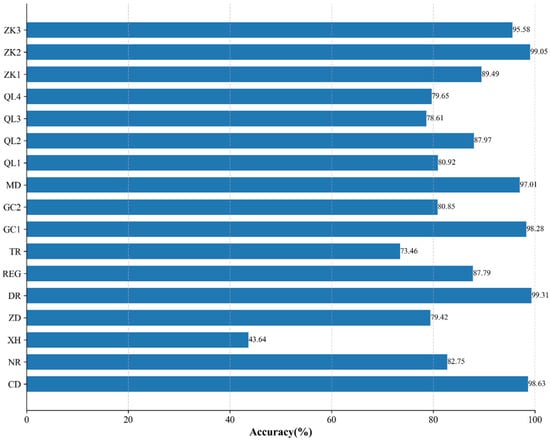
Figure 3.
The classification accuracies based on UAV image verification.
Moreover, when overlaid with the hillslope thermokarst dataset (Figure 4), approximately 461 out of the 522 features intersect with the RF-derived FTDR, indicating an 88.34% agreement between the study’s results and the hillslope thermokarst dataset, thus confirming the high credibility of the findings.
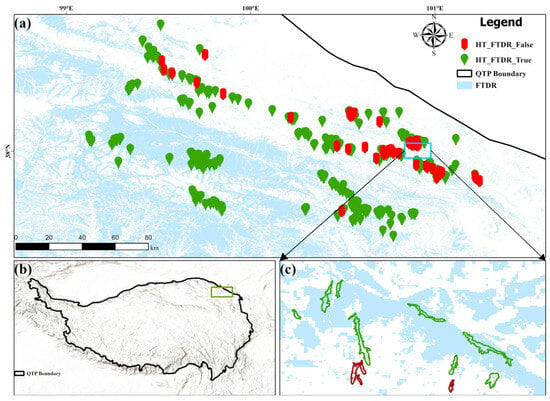
Figure 4.
Spatial overlap of hillslope thermokarst datasets and the FTDR: (a) hillslope thermokarst distribution; green indicates overlap with the results of this study, red indicates the opposite; (b) location of the Qinghai–Tibet Plateau in (a); and (c) view of the location of the local rectangular box in (b).
Overall, the validation results from both the hillslope thermokarst dataset and the UAV image data demonstrate that the FTDR identified in this study is highly accurate and reliable, effectively representing typical thermokarst landforms in the region.
4.2. RF-Derived FTDR
The RF-derived FTDR in the QTP is illustrated in Figure 5. As shown in Figure 5, the FTDR is primarily distributed in the central and eastern parts of the QTP, covering a total area of 2.96 × 105 km2 and accounting for 8.85% of the total area of the QTP. According to the permafrost distribution data described in Section 2.2.3, approximately 42% of the FTDRs are located in permafrost, and 58% are located in the SFG. By overlaying the FTDR with the permafrost distribution data, it is found that the FTDRs are mainly distributed in discontinuous permafrost and the intersections of permafrost and SFG. Moreover, most of the FTDRs in SFG are located at the edge of the region.
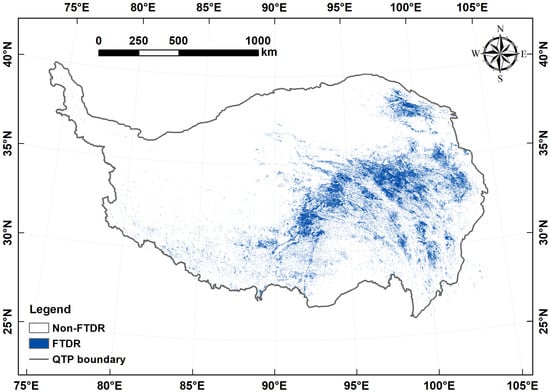
Figure 5.
Distribution of the RF-derived FTDRs in the QTP.
The statistics (Figure 6) show that SFGs dominated the FTDR, covering an area of 56.87%. Within the FTDR, the permafrost types are mainly transitional (21.44%) and unstable (15.15%), followed by the semi-stable (6.25%) and stable (0.28%) types. Notably, within the SFG and the unstable and transitional permafrost, the FTDRs account for a greater percentage than the non-FTDR areas. In contrast, within the semi-stable, stable, and very stable permafrost, the FTDRs account for a much smaller percentage than the non-FTDR areas. The above statistical results indicate that the FTDRs are predominantly located in the SFG and the transitional and unstable permafrost zones.
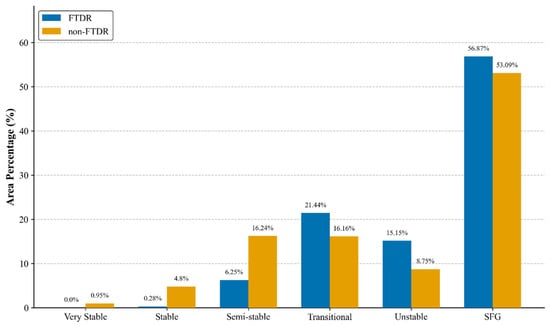
Figure 6.
Area percentages of permafrost and seasonally frozen ground in the FTDR and non-FTDR areas.
The spatial concentration of FTDR in the central and eastern Tibetan Plateau (Figure 5) reflects the combined effects of climate, geomorphology, and permafrost conditions. These regions coincide with discontinuous permafrost zones, where ground-ice melting and altered surface thermal regimes intensify active layer dynamics and hydrological fluxes, thereby fostering the dense development of thermokarst landforms. Compared with the more stable continuous permafrost in the western plateau, these areas are more prone to thaw-related disturbances, creating favorable conditions for geomorphic instability.
Figure 7 presents a statistical comparison of the DEM, slope, MAGT, and SM between the FTDR and non-FTDR areas. As shown in Figure 7a, the FTDRs are distributed across elevations ranging from 3000 to 6000 m, with an average elevation of 4445 m. Notably, approximately 87.7% of the FTDRs are located between 4000 and 4800 m. Figure 7b indicates that the FTDRs tend to develop in regions with gentler slopes, with a mean slope of 4.23°, which is lower than that of non-FTDR areas (6.47°). Figure 7c shows that the average MAGT in FTDR areas (0.28 °C) is greater than that in non-FTDR areas (0 °C), with most FTDRs occurring near the 0 °C threshold, indicating their presence in relatively warm permafrost. An examination of the average soil moisture (SM) values that were calculated from ERA-5 data for 40 years (1980–2020) revealed that the SM in FTDRs is much higher, with a medium value of 0.37 m3/m3 and generally varies within a narrower dynamic range (0.36–0.38 m3/m3), which differs significantly from that in the non-FTDRs (0.3 m3/m3, 0.15–0.37 m3/m3) (Figure 7d).
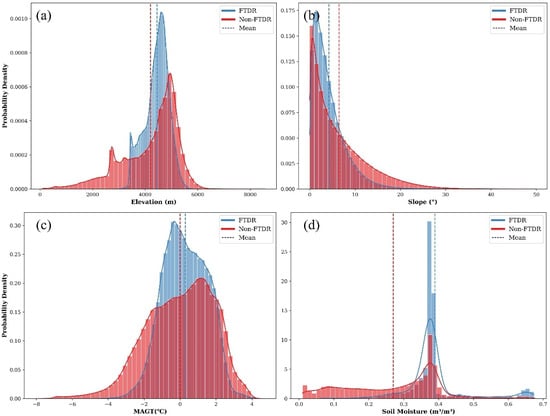
Figure 7.
Statistics of (a) DEM, (b) slope, (c) MAGT, and (d) SM over FTDR and non-FTDR areas.
4.3. The FTDR-Derived FTDI
The FTDI can be obtained via the method described in Section 3.2, as shown in Figure 8. Notably, a sufficiently small FTDI implies a very tiny portion of the FTDR within the region. According to the FTDI accuracy curve, higher FTDI values correspond to greater credibility of FTDI. To minimize uncertainty, we excluded areas with FTDI values below 0.1 from subsequent analyses. This threshold is reasonable because, from a spatial distribution perspective, regions with sparse landforms are more susceptible to misclassification, thereby introducing greater uncertainty into FTDI estimates. On the basis of this consideration, the areas with FTDIs less than 0.1 were masked. Unless otherwise specified, all the following discussion is conducted for FTDI ranging from 0.1 to 1. According to Figure 8, the area affected by a freeze–thaw disturbance on the QTP is 6.61 × 105 km2, which is primarily distributed in southern and northeastern Qinghai Province, northeastern Tibet Autonomous Region, and western Sichuan Province. Figure 9 shows the FTDI distribution across different latitudes and longitudes, revealing pronounced freeze–thaw disturbance processes in the central and eastern regions of the QTP.
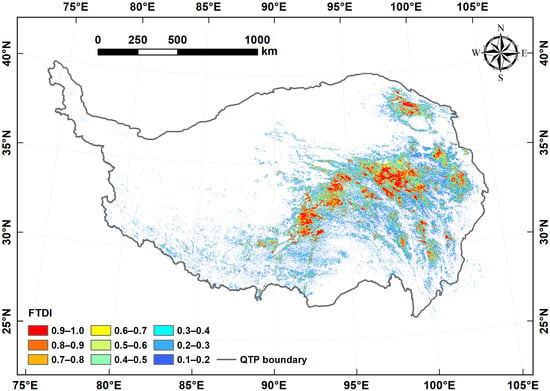
Figure 8.
Distribution of the FTDR-derived FTDI in the QTP.
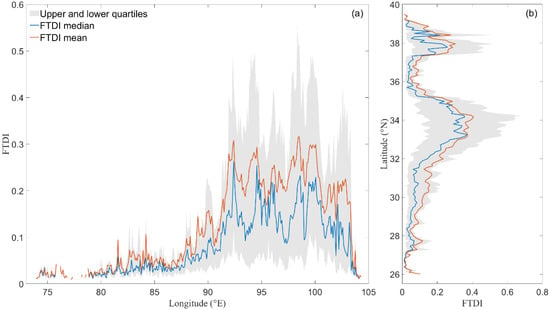
Figure 9.
Variations in the average FTDI with changes in (a) longitude and (b) latitude.
Figure 10 shows the relationships between the FTDI and MAGT, as well as between the FTDI and SM, with the FTDI increasing from 0.1 to 1 in increments of 0.01. Notably, the FTDI in each step is obtained via a 1000-member bootstrapping method, which is used in the plots to present the relationships more effectively. The FTDI and MAGT are negatively correlated, and the FTDI and SM are positively correlated. This phenomenon suggests that a lower MAGT and higher SM are often present in areas with stronger FTDI, while weaker FTDI values generally correspond to regions that are characterized by higher MAGTs and smaller SM.

Figure 10.
Variations in (a) MAGT and (b) SM with the FTDI. The red dashed line indicates the general trend.
5. Discussion
5.1. Characterizing the FTDR and FTDI on the Basis of Freeze–Thaw Factors
As shown in Figure 11a, there are significant differences in the freeze–thaw factors between the FTDR and non-FTDR areas. The number of FF days in FTDR areas is notably greater than that in non-FTDR areas, whereas the numbers of FT and TT days exhibit the opposite trend. Additionally, the duration of the freeze–thaw cycle period (T-F_period, T-F_period) is shorter in FTDR areas. These differences suggest that the FTDR, as proposed in this study, primarily reflects the freezing factor in the freeze–thaw process. The FTDR is based on surface collapse areas and is directly related to ground-interface processes, highlighting that the number of frozen days is the key factor influencing the freeze–thaw process in surface soils rather than the number of freeze–thaw transitional days. Although the frozen state persists for an extended period in areas where the FTDR is located, Figure 6 and Figure 7 indicate that the permafrost in these regions is thermally unstable, with MAGT values approaching 0 °C. This suggests that even slight temperature increases are more likely to disrupt the existing frozen state, rendering the soil more vulnerable to thermal fluctuations and subsequent deformation.
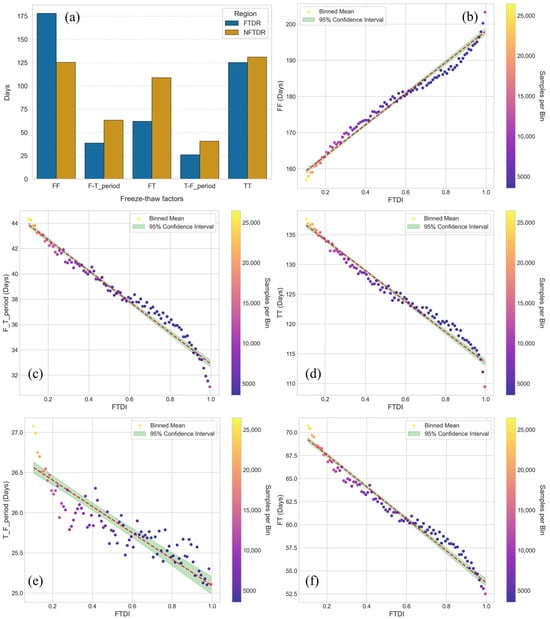
Figure 11.
(a) Average freeze–thaw factors for the FTDR and non-FTDRs and (b–f) freeze–thaw factors for different FTDI regions. The red dashed line has the same meaning as in Figure 10.
To gain a better understanding of the meaning of the FTDI, a relationship between the FTDI and a specific freeze–thaw factor was established (Figure 11b–f). In regions with greater FTDI values, the soil has more FF days, shorter FT days, and shorter TT days. Among the different FTDI regions, the differences in FF days are significant, followed by TT days, whereas the differences in FT days are minimal. Furthermore, considering that FT days occur primarily in spring and autumn, this study also compared the number of freeze–thaw cycles season days within different FTDI regions (Figure 11c,e). The results indicate that both F-T_period and T-F_period days are shorter in regions with a greater FTDI. Moreover, the difference in F-T_period is greater than the difference in T-F_period, which suggests that in regions with greater FTDI, the soil undergoes shorter FT days in spring, transitioning more rapidly from a frozen state to a thawed state. This freeze–thaw process refers to the frequent occurrence of surface thaw driven by climate change, which differs from the traditional daily freeze–thaw cycle.
The results above indicate that stronger FTDI values correspond to longer durations of surface freezing and shorter cycle periods from the frozen to thawed state. According to the definition of the FTDI, larger values signify a denser distribution of FTDRs, suggesting a greater disturbance of the land surface in these regions. Specifically, although these areas remain in a frozen state for extended periods, their relatively high MAGT reflects low frozen soil stability. Under the influence of climate change, rising temperatures lead to a more rapid transition of the surface from a frozen state to a thawed state, which affects the soil structure and leads to disturbed landforms in these regions. This implies that more attention should be given to variables such as FF days and the duration of spring thawing in response to climate change when studying freeze–thaw processes. The impact of thaw processes on soil is relatively significant, whereas the influence of daily freeze–thaw alternations is relatively small.
The above analysis demonstrates that although the FTDI developed in this study is derived from landform density, it remains closely linked to freeze–thaw processes. Unlike traditional freeze–thaw counts, the FTDI captures the spatial distribution of surface disturbances, thereby reflecting, to some extent, the influence of surface freeze–thaw transitions and complementing conventional process-based indicators. Higher FTDI values indicate an increased likelihood of local freeze–thaw transitions driven by rising temperatures, with direct implications for surface processes and soil quality. Moreover, whereas thermal stability maps represent long-term averages of subsurface conditions, the FTDI reflects recent surface disturbance dynamics that can be directly detected using remote sensing imagery. This property makes FTDI particularly valuable for monitoring ecosystem change and assessing infrastructure vulnerability. In summary, while conventional indicators such as freeze–thaw days or active layer thickness capture subsurface thermal dynamics, they lack a direct connection to actual surface conditions. The FTDI complements these approaches by providing a spatially explicit geomorphic indicator of disturbance density derived from remote sensing, which highlights the landscape-level imprint of freeze–thaw dynamics.
5.2. The Indicative Significance of FTDI for SOC Stocks and Vegetation Phenology
5.2.1. SOC Stocks
Figure 12a shows the soil organic carbon (SOC) contents (0–30 cm depth) across regions with varying FTDI values (using the same 1000-member bootstrapping method as in Figure 10). Areas with higher FTDI values tend to exhibit greater SOC contents. As higher FTDI values indicate denser distributions of the FTDR, these regions are expected to experience more significant surface changes in response to future temperature increases. Previous studies [,,,] have demonstrated that surface disturbances in permafrost regions can expose stored SOC, leading to increased greenhouse gas emissions. Therefore, regions with high FTDIs warrant particular attention, as they have critical implications for understanding greenhouse gas emissions in permafrost areas under the influence of climate change.
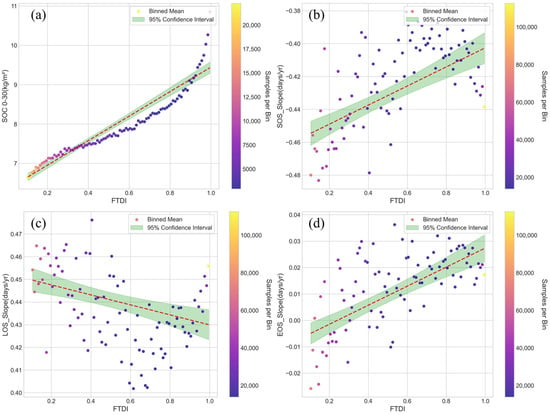
Figure 12.
(a) FTDI stratified SOC contents at 0–30 cm depth. Trends of (b) SOS, (c) LOS, and (d) EOS in vegetation phenology over the past two decades across regions with different FTDI levels based on a 1000-member bootstrapping analysis with an FTDI step of 0.1. The red dashed line has the same meaning as in Figure 10.
5.2.2. Vegetation Phenology
Changes in vegetation phenology on the QTP under the influence of climate change have been characterized by an earlier SOS and a delayed EOS []. However, the impact of soil freeze–thaw processes on vegetation dynamics remains unclear, with existing studies adopting various quantitative indicators to describe freeze–thaw conditions [,]. The FTDI proposed in this study is a geomorphic aggregation index that indirectly reflects the changes in the freeze–thaw process, offering a new perspective for investigating vegetation phenology. Figure 12b–d shows the trends in vegetation phenology over the past two decades across regions with different FTDI levels, including the SOS, EOS, and LOS. In regions with high FTDI values, the advance rate of the SOS slows, the delay rate of the EOS increases, and the extension of the LOS length becomes less pronounced. These patterns suggest that freeze–thaw disturbances induced by climate change primarily hinder the early onset of vegetation growth, thereby exerting a negative influence on vegetation phenology. This may be attributed to the greater likelihood of thermokarst landform development in areas with elevated FTDI values, which alters the native growth environment and delays vegetation responses to climatic changes. While both vegetation and soil freeze–thaw processes respond to climate change, the freeze–thaw state of the soil directly affects surface conditions, thereby influencing vegetation dynamics—an interaction that is often overlooked. The FTDI captures this coupling, offering a novel perspective for exploring vegetation phenology dynamics in the context of climate change. While delayed vegetation phenology in high-FTDI areas may result from habitat changes induced by thermokarst processes, other factors such as interannual precipitation variability, soil moisture dynamics, grazing pressure, and human disturbance could also contribute. However, due to the lack of reliable data, the dataset used in this work did not incorporate these variables. Future studies integrating remote-sensing vegetation indices with climate records, land-use datasets, and field observations are needed to disentangle these overlapping influences.
5.3. Limitations
Although this study proposed the FTDI to quantify geomorphic disturbance processes, several it should still be acknowledged that there are limitations to this work. First, this study used 2020 as a representative year to develop and evaluate the FTDI framework. However, there is uncertainty regarding the framework’s long-term application, and its applicability requires further analysis. Future research should incorporate multi-year datasets for more robust long-term monitoring and assessment. Second, a key limitation of the FTDI is that it does not explicitly incorporate critical environmental variables, such as ground-ice content and soil stratigraphy; however, due to the absence of unified datasets covering the entire plateau, these factors could not be included in the current framework. Future work combining FTDI with auxiliary datasets (e.g., ground-ice content) would provide a more comprehensive understanding of its underlying mechanisms. In addition, processes such as phase-change buffering and variations in soil moisture table depth can modulate freeze–thaw responses. Future studies integrating sub-daily temperature records and soil moisture proxies could help address these limitations and refine the interpretation of FTDI. In the future, greater attention should be given to quantitative characterizations of freeze–thaw processes, particularly by strengthening research on their relationships with cold-region landforms. This will enhance our understanding of how freeze–thaw dynamics influence surface processes in the context of climate change.
6. Conclusions
This study focuses on thermokarst landforms in permafrost regions and uses Sentinel-2 satellite data to identify the spatial distribution of freeze–thaw disturbance regions (FTDRs) on the QTP via a random forest model, which is highly consistent with ground observations. From these results, we developed a density-based Freeze–Thaw Disturbance Index (FTDI) to quantify the spatial clustering of disturbance features. While FTDI does not directly measure thermal processes, it serves as a geomorphic indicator of freeze–thaw disturbance potential, reflecting the broader impacts of freeze–thaw dynamics on surface systems under climate change. The main conclusions are as follows:
(1) FTDRs account for 8.85% of the total area of the QTP and are primarily distributed in its central and eastern regions. These areas exhibit prolonged freezing durations, and the mean annual ground temperature (MAGT) is close to 0 °C, indicating thermally unstable permafrost. Therefore, the soils in these regions are highly susceptible to disturbances induced by global warming.
(2) Most areas of the QTP exhibit low or negligible FTDI values. The FTDI reflects the extent to which freeze–thaw changes driven by climate change influence the soil. Higher FTDI values indicate a greater likelihood of surface thaw transitions triggered by rising temperatures, which impact surface processes. This highlights the importance of incorporating seasonal freeze–thaw processes dynamics when assessing the effects of freeze–thaw processes on soil quality.
(3) The FTDI serves as an important indicator in the context of climate change. Regions with relatively high FTDI values often contain substantial amounts of soil organic carbon, highlighting their potential contribution to greenhouse gas emissions and the need for closer monitoring. Additionally, freeze–thaw disturbances have partially suppressed the trend of earlier growing seasons that are driven by climate change, and the underlying mechanisms behind this interaction warrant further investigation.
In summary, the FTDI developed in this study serves as a density-based geomorphic disturbance index. By linking FTDI with existing freeze–thaw process indicators, it indirectly indicates that long-term surface freeze–thaw changes are critical processes shaping geomorphology. Furthermore, FTDI can be used as a spatial indicator to guide sampling strategies and assess the potential impacts of permafrost changes on soil carbon dynamics. The FTDI thus provides a reference framework for the quantitative evaluation of freeze–thaw processes and offers new insights into their study under a changing climate.
Author Contributions
Conceptualization, Z.J. and L.C.; methodology, Z.J.; software, Z.J.; validation, Z.J., L.C. and S.Z.; formal analysis, Z.J.; investigation, Z.J. and S.Z.; resources, L.C.; data curation, L.C.; writing—original draft preparation, Z.J.; writing—review and editing, Z.J. and L.C.; visualization, Z.J. and L.C.; supervision, L.C., X.L., C.X. and S.L.; project administration, L.C.; funding acquisition, L.C. All authors have read and agreed to the published version of the manuscript.
Funding
The work was supported by the Second Tibetan Plateau Scientific Expedition and Research Program (STEP) (2019QZKK0306) and the National Natural Science Foundation of China (42171319).
Data Availability Statement
The datasets presented in this paper is available through https://doi.org/10.11888/Cryos.tpdc.301082.
Conflicts of Interest
The authors declare no conflicts of interest.
References
- Yang, M.; Yao, T.; Gou, X.; Hirose, N.; Fujii, H.Y.; Hao, L.; Levia, D.F. Diurnal Freeze/Thaw Cycles of the Ground Surface on the Tibetan Plateau. Chin. Sci. Bull. 2007, 52, 136–139. [Google Scholar] [CrossRef]
- Langer, M.; Westermann, S.; Muster, S.; Piel, K.; Boike, J. The Surface Energy Balance of a Polygonal Tundra Site in Northern Siberia—Part 2: Winter. Cryosphere 2011, 5, 509–524. [Google Scholar] [CrossRef]
- Rawlins, M.A.; Nicolsky, D.J.; McDonald, K.C.; Romanovsky, V.E. Simulating Soil Freeze/Thaw Dynamics with an Improved pan--Arctic Water Balance Model. J. Adv. Model. Earth Syst. 2013, 5, 659–675. [Google Scholar] [CrossRef]
- Zheng, G.; Yang, Y.; Yang, D.; Dafflon, B.; Lei, H.; Yang, H. Satellite-Based Simulation of Soil Freezing/Thawing Processes in the Northeast Tibetan Plateau. Remote Sens. Environ. 2019, 231, 111269. [Google Scholar] [CrossRef]
- Jiang, H.; Yi, Y.; Zhang, W.; Yang, K.; Chen, D. Sensitivity of Soil Freeze/Thaw Dynamics to Environmental Conditions at Different Spatial Scales in the Central Tibetan Plateau. Sci. Total Environ. 2020, 734, 139261. [Google Scholar] [CrossRef]
- Chen, X.; Jeong, S.; Park, C.-E.; Park, H.; Joo, J.; Chang, D.; Yun, J. Different Responses of Surface Freeze and Thaw Phenology Changes to Warming among Arctic Permafrost Types. Remote Sens. Environ. 2022, 272, 112956. [Google Scholar] [CrossRef]
- Sun, Z.; Wang, Y.; Sun, Y.; Niu, F.; GuoyuLi; Gao, Z. Creep Characteristics and Process Analyses of a Thaw Slump in the Permafrost Region of the Qinghai-Tibet Plateau, China. Geomorphology 2017, 293, 1–10. [Google Scholar] [CrossRef]
- Wang, Y.; Sun, Z.; Sun, Y. Effects of a Thaw Slump on Active Layer in Permafrost Regions with the Comparison of Effects of Thermokarst Lakes on the Qinghai–Tibet Plateau, China. Geoderma 2018, 314, 47–57. [Google Scholar] [CrossRef]
- Lewkowicz, A.G.; Way, R.G. Extremes of Summer Climate Trigger Thousands of Thermokarst Landslides in a High Arctic Environment. Nat. Commun. 2019, 10, 1329. [Google Scholar] [CrossRef]
- Mu, C.; Shang, J.; Zhang, T.; Fan, C.; Wang, S.; Peng, X.; Zhong, W.; Zhang, F.; Mu, M.; Jia, L. Acceleration of Thaw Slump during 1997–2017 in the Qilian Mountains of the Northern Qinghai-Tibetan Plateau. Landslides 2020, 17, 1051–1062. [Google Scholar] [CrossRef]
- Schuur, E.A.G.; McGuire, A.D.; Schädel, C.; Grosse, G.; Harden, J.W.; Hayes, D.J.; Hugelius, G.; Koven, C.D.; Kuhry, P.; Lawrence, D.M.; et al. Climate Change and the Permafrost Carbon Feedback. Nature 2015, 520, 171–179. [Google Scholar] [CrossRef]
- Turetsky, M.R.; Abbott, B.W.; Jones, M.C.; Walter Anthony, K.; Olefeldt, D.; Schuur, E.A.G.; Koven, C.; McGuire, A.D.; Grosse, G.; Kuhry, P.; et al. Permafrost Collapse Is Accelerating Carbon Release. Nature 2019, 569, 32–34. [Google Scholar] [CrossRef]
- Mu, C.; Abbott, B.W.; Norris, A.J.; Mu, M.; Fan, C.; Chen, X.; Jia, L.; Yang, R.; Zhang, T.; Wang, K.; et al. The Status and Stability of Permafrost Carbon on the Tibetan Plateau. Earth-Sci. Rev. 2020, 211, 103433. [Google Scholar] [CrossRef]
- Jin, X.-Y.; Jin, H.-J.; Iwahana, G.; Marchenko, S.S.; Luo, D.-L.; Li, X.-Y.; Liang, S.-H. Impacts of Climate-Induced Permafrost Degradation on Vegetation: A Review. Adv. Clim. Change Res. 2021, 12, 29–47. [Google Scholar] [CrossRef]
- Jin, X.; Jin, H.; Luo, D.; Sheng, Y.; Wu, Q.; Wu, J.; Wang, W.; Huang, S.; Li, X.; Liang, S.; et al. Impacts of Permafrost Degradation on Hydrology and Vegetation in the Source Area of the Yellow River on Northeastern Qinghai-Tibet Plateau, Southwest China. Front. Earth Sci. 2022, 10, 845824. [Google Scholar] [CrossRef]
- Olefeldt, D.; Goswami, S.; Grosse, G.; Hayes, D.; Hugelius, G.; Kuhry, P.; McGuire, A.D.; Romanovsky, V.E.; Sannel, A.B.K.; Schuur, E.A.G.; et al. Circumpolar Distribution and Carbon Storage of Thermokarst Landscapes. Nat. Commun. 2016, 7, 13043. [Google Scholar] [CrossRef] [PubMed]
- Abbott, B.W.; Jones, J.B. Permafrost Collapse Alters Soil Carbon Stocks, Respiration, CH4, and N2O in Upland Tundra. Glob. Change Biol. 2015, 21, 4570–4587. [Google Scholar] [CrossRef] [PubMed]
- Mu, C.; Zhang, T.; Zhang, X.; Li, L.; Guo, H.; Zhao, Q.; Cao, L.; Wu, Q.; Cheng, G. Carbon Loss and Chemical Changes from Permafrost Collapse in the Northern Tibetan Plateau. J. Geophys. Res. Biogeosciences 2016, 121, 1781–1791. [Google Scholar] [CrossRef]
- Liu, F.; Chen, L.; Abbott, B.W.; Xu, Y.; Yang, G.; Kou, D.; Qin, S.; Strauss, J.; Wang, Y.; Zhang, B.; et al. Reduced Quantity and Quality of SOM along a Thaw Sequence on the Tibetan Plateau. Environ. Res. Lett. 2018, 13, 104017. [Google Scholar] [CrossRef]
- Wang, T.; Yang, D.; Yang, Y.; Piao, S.; Li, X.; Cheng, G.; Fu, B. Permafrost Thawing Puts the Frozen Carbon at Risk over the Tibetan Plateau. Sci. Adv. 2020, 6, eaaz3513. [Google Scholar] [CrossRef]
- Jones, B.M.; Grosse, G.; Arp, C.D.; Jones, M.C.; Walter Anthony, K.M.; Romanovsky, V.E. Modern Thermokarst Lake Dynamics in the Continuous Permafrost Zone, Northern Seward Peninsula, Alaska. J. Geophys. Res. 2011, 116, G00M03. [Google Scholar] [CrossRef]
- Karlsson, J.M.; Lyon, S.W.; Destouni, G. Thermokarst Lake, Hydrological Flow and Water Balance Indicators of Permafrost Change in Western Siberia. J. Hydrol. 2012, 464–465, 459–466. [Google Scholar] [CrossRef]
- Olthof, I.; Fraser, R.H.; Schmitt, C. Landsat-Based Mapping of Thermokarst Lake Dynamics on the Tuktoyaktuk Coastal Plain, Northwest Territories, Canada since 1985. Remote Sens. Environ. 2015, 168, 194–204. [Google Scholar] [CrossRef]
- Armstrong, L.; Lacelle, D.; Fraser, R.H.; Kokelj, S.; Knudby, A. Thaw Slump Activity Measured Using Stationary Cameras in Time-Lapse and Structure-from-Motion Photogrammetry. Arct. Sci. 2018, 4, 827–845. [Google Scholar] [CrossRef]
- Balser, A.W.; Jones, J.B.; Gens, R. Timing of Retrogressive Thaw Slump Initiation in the Noatak Basin, Northwest Alaska, USA. J. Geophys. Res. Earth Surf. 2014, 119, 1106–1120. [Google Scholar] [CrossRef]
- Lantuit, H.; Pollard, W.H. Fifty Years of Coastal Erosion and Retrogressive Thaw Slump Activity on Herschel Island, Southern Beaufort Sea, Yukon Territory, Canada. Geomorphology 2008, 95, 84–102. [Google Scholar] [CrossRef]
- Lantz, T.C.; Kokelj, S.V. Increasing Rates of Retrogressive Thaw Slump Activity in the Mackenzie Delta Region, N.W.T., Canada. Geophys. Res. Lett. 2008, 35, L06502. [Google Scholar] [CrossRef]
- Swanson, D.K.; Nolan, M. Growth of Retrogressive Thaw Slumps in the Noatak Valley, Alaska, 2010–2016, Measured by Airborne Photogrammetry. Remote Sens. 2018, 10, 983. [Google Scholar] [CrossRef]
- Brooker, A.; Fraser, R.H.; Olthof, I.; Kokelj, S.V.; Lacelle, D. Mapping the Activity and Evolution of Retrogressive Thaw Slumps by Tasselled Cap Trend Analysis of a Landsat Satellite Image Stack. Permafr. Periglac. Process. 2014, 25, 243–256. [Google Scholar] [CrossRef]
- Lara, M.J.; Chipman, M.L.; Hu, F.S. Automated Detection of Thermoerosion in Permafrost Ecosystems Using Temporally Dense Landsat Image Stacks. Remote Sens. Environ. 2019, 221, 462–473. [Google Scholar] [CrossRef]
- Runge, A.; Nitze, I.; Grosse, G. Remote Sensing Annual Dynamics of Rapid Permafrost Thaw Disturbances with LandTrendr. Remote Sens. Environ. 2022, 268, 112752. [Google Scholar] [CrossRef]
- Zou, D.; Zhao, L.; Sheng, Y.; Chen, J.; Hu, G.; Wu, T.; Wu, J.; Xie, C.; Wu, X.; Pang, Q.; et al. A New Map of Permafrost Distribution on the Tibetan Plateau. Cryosphere 2017, 11, 2527–2542. [Google Scholar] [CrossRef]
- Shading, W. Thaw Slumping in Fenghuo Mountain Area Along Qinghai-Xizang Highway. J. Glaciol. Geocryol. 1990, 12, 63–70. [Google Scholar]
- Luo, J.; Niu, F.; Lin, Z.; Liu, M.; Yin, G. Recent Acceleration of Thaw Slumping in Permafrost Terrain of Qinghai-Tibet Plateau: An Example from the Beiluhe Region. Geomorphology 2019, 341, 79–85. [Google Scholar] [CrossRef]
- Huang, L.; Liu, L.; Jiang, L.; Zhang, T. Automatic Mapping of Thermokarst Landforms from Remote Sensing Images Using Deep Learning: A Case Study in the Northeastern Tibetan Plateau. Remote Sens. 2018, 10, 2067. [Google Scholar] [CrossRef]
- Huang, L.; Liu, L.; Luo, J.; Lin, Z.; Niu, F. Automatically Quantifying Evolution of Retrogressive Thaw Slumps in Beiluhe (Tibetan Plateau) from Multi-Temporal CubeSat Images. Int. J. Appl. Earth Obs. Geoinformation 2021, 102, 102399. [Google Scholar] [CrossRef]
- Huang, L.; Luo, J.; Lin, Z.; Niu, F.; Liu, L. Using Deep Learning to Map Retrogressive Thaw Slumps in the Beiluhe Region (Tibetan Plateau) from CubeSat Images. Remote Sens. Environ. 2020, 237, 111534. [Google Scholar] [CrossRef]
- Wei, Z.; Du, Z.; Wang, L.; Lin, J.; Feng, Y.; Xu, Q.; Xiao, C. Sentinel—Based Inventory of Thermokarst Lakes and Ponds Across Permafrost Landscapes on the Qinghai—Tibet Plateau. Earth Space Sci. 2021, 8, e2021EA001950. [Google Scholar] [CrossRef]
- Luo, J.; Niu, F.; Lin, Z.; Liu, M.; Yin, G.; Gao, Z. Inventory and Frequency of Retrogressive Thaw Slumps in Permafrost Region of the Qinghai–Tibet Plateau. Geophys. Res. Lett. 2022, 49, e2022GL099829. [Google Scholar] [CrossRef]
- Peng, X.; Yang, G.; Frauenfeld, O.W.; Li, X.; Tian, W.; Chen, G.; Huang, Y.; Wei, G.; Luo, J.; Mu, C.; et al. The First Hillslope Thermokarst Inventory for the Permafrost Region of the Qilian Mountains. Earth Syst. Sci. Data 2024, 16, 2033–2045. [Google Scholar] [CrossRef]
- Deng, Y.; Li, X.; Shi, F.; Chai, L.; Zhao, S.; Ding, M.; Liao, Q. Nonlinear Effects of Thermokarst Lakes on Peripheral Vegetation Greenness across the Qinghai-Tibet Plateau Using Stable Isotopes and Satellite Detection. Remote Sens. Environ. 2022, 280, 113215. [Google Scholar] [CrossRef]
- Ding, J.; Chen, L.; Ji, C.; Hugelius, G.; Li, Y.; Liu, L.; Qin, S.; Zhang, B.; Yang, G.; Li, F.; et al. Decadal Soil Carbon Accumulation across Tibetan Permafrost Regions. Nat. Geosci. 2017, 10, 420–424. [Google Scholar] [CrossRef]
- Ran, Y.; Li, X.; Cheng, G.; Nan, Z.; Che, J.; Sheng, Y.; Wu, Q.; Jin, H.; Luo, D.; Tang, Z.; et al. Mapping the Permafrost Stability on the Tibetan Plateau for 2005–2015. Sci. China Earth Sci. 2021, 64, 62–79. [Google Scholar] [CrossRef]
- Cheng, G.; Zhao, L.; Li, R.; Wu, X.; Sheng, Y.; Hu, G.; Zou, D.; Jin, H.; Wu, Q. Characteristic, Changes and Impacts of Permafrost on Qinghai-Tibet Plateau. Chin. Sci. Bull. 2019, 64, 2783–2795. [Google Scholar] [CrossRef]
- Fu, Y.-H.; Gao, X.-J.; Zhu, Y.-M.; Guo, D. Climate Change Projection over the Tibetan Plateau Based on a Set of RCM Simulations. Adv. Clim. Change Res. 2021, 12, 313–321. [Google Scholar] [CrossRef]
- Gao, T.; Zhang, Y.; Kang, S.; Abbott, B.W.; Wang, X.; Zhang, T.; Yi, S.; Gustafsson, Ö. Accelerating Permafrost Collapse on the Eastern Tibetan Plateau. Environ. Res. Lett. 2021, 16, 054023. [Google Scholar] [CrossRef]
- Fitton, J.M.; Rennie, A.F.; Hansom, J.D.; Muir, F.M.E. Remotely Sensed Mapping of the Intertidal Zone: A Sentinel-2 and Google Earth Engine Methodology. Remote Sens. Appl. Soc. Environ. 2021, 22, 100499. [Google Scholar] [CrossRef]
- Gorelick, N.; Hancher, M.; Dixon, M.; Ilyushchenko, S.; Thau, D.; Moore, R. Google Earth Engine: Planetary-Scale Geospatial Analysis for Everyone. Remote Sens. Environ. 2017, 202, 18–27. [Google Scholar] [CrossRef]
- Bunting, E.L.; Munson, S.M.; Bradford, J.B. Assessing Plant Production Responses to Climate across Water-Limited Regions Using Google Earth Engine. Remote Sens. Environ. 2019, 233, 111379. [Google Scholar] [CrossRef]
- Deines, J.M.; Kendall, A.D.; Crowley, M.A.; Rapp, J.; Cardille, J.A.; Hyndman, D.W. Mapping Three Decades of Annual Irrigation across the US High Plains Aquifer Using Landsat and Google Earth Engine. Remote Sens. Environ. 2019, 233, 111400. [Google Scholar] [CrossRef]
- Jin, Z.; Azzari, G.; You, C.; Di Tommaso, S.; Aston, S.; Burke, M.; Lobell, D.B. Smallholder Maize Area and Yield Mapping at National Scales with Google Earth Engine. Remote Sens. Environ. 2019, 228, 115–128. [Google Scholar] [CrossRef]
- Wong, B.A.; Thomas, C.; Halpin, P. Automating Offshore Infrastructure Extractions Using Synthetic Aperture Radar & Google Earth Engine. Remote Sens. Environ. 2019, 233, 111412. [Google Scholar] [CrossRef]
- Gong, P.; Li, X.; Wang, J.; Bai, Y.; Chen, B.; Hu, T.; Liu, X.; Xu, B.; Yang, J.; Zhang, W.; et al. Annual Maps of Global Artificial Impervious Area (GAIA) between 1985 and 2018. Remote Sens. Environ. 2020, 236, 111510. [Google Scholar] [CrossRef]
- Zhou, B.; Okin, G.S.; Zhang, J. Leveraging Google Earth Engine (GEE) and Machine Learning Algorithms to Incorporate in Situ Measurement from Different Times for Rangelands Monitoring. Remote Sens. Environ. 2020, 236, 111521. [Google Scholar] [CrossRef]
- Pan, X.; Guo, X.; Li, X.; Niu, X.; Yang, X.; Feng, M.; Che, T.; Jin, R.; Ran, Y.; Guo, J.; et al. National Tibetan Plateau Data Center: Promoting Earth System Science on the Third Pole. Bull. Am. Meteorol. Soc. 2021, 102, E2062–E2078. [Google Scholar] [CrossRef]
- Liu, F.; Wu, H.; Zhao, Y.; Li, D.; Yang, J.-L.; Song, X.; Shi, Z.; Zhu, A.-X.; Zhang, G.-L. Mapping High Resolution National Soil Information Grids of China. Sci. Bull. 2022, 67, 328–340. [Google Scholar] [CrossRef]
- Friedl, M.; Gray, J.; Sulla-Menashe, D. MCD12Q2 MODIS/Terra + Aqua Land Cover Dynamics Yearly L3 Global 500 m SIN Grid V006 [Data set]. NASA Land Processes Distributed Active Archive Center. 2019. Available online: https://doi.org/10.5067/MODIS/MCD12Q2.006 (accessed on 17 September 2025).
- Yu, H.; Luedeling, E.; Xu, J. Winter and Spring Warming Result in Delayed Spring Phenology on the Tibetan Plateau. Proc. Natl. Acad. Sci. USA 2010, 107, 22151–22156. [Google Scholar] [CrossRef]
- Shen, M.; Wang, S.; Jiang, N.; Sun, J.; Cao, R.; Ling, X.; Fang, B.; Zhang, L.; Zhang, L.; Xu, X.; et al. Plant Phenology Changes and Drivers on the Qinghai–Tibetan Plateau. Nat. Rev. Earth Environ. 2022, 3, 633–651. [Google Scholar] [CrossRef]
- Gibson, R.; Danaher, T.; Hehir, W.; Collins, L. A Remote Sensing Approach to Mapping Fire Severity in South-Eastern Australia Using Sentinel 2 and Random Forest. Remote Sens. Environ. 2020, 240, 111702. [Google Scholar] [CrossRef]
- Loozen, Y.; Rebel, K.T.; De Jong, S.M.; Lu, M.; Ollinger, S.V.; Wassen, M.J.; Karssenberg, D. Mapping Canopy Nitrogen in European Forests Using Remote Sensing and Environmental Variables with the Random Forests Method. Remote Sens. Environ. 2020, 247, 111933. [Google Scholar] [CrossRef]
- Zhang, F.; Yang, X. Improving Land Cover Classification in an Urbanized Coastal Area by Random Forests: The Role of Variable Selection. Remote Sens. Environ. 2020, 251, 112105. [Google Scholar] [CrossRef]
- Bao, F.; Huang, K.; Wu, S. The Retrieval of Aerosol Optical Properties Based on a Random Forest Machine Learning Approach: Exploration of Geostationary Satellite Images. Remote Sens. Environ. 2023, 286, 113426. [Google Scholar] [CrossRef]
- Lacelle, D.; Brooker, A.; Fraser, R.H.; Kokelj, S.V. Distribution and Growth of Thaw Slumps in the Richardson Mountains–Peel Plateau Region, Northwestern Canada. Geomorphology 2015, 235, 40–51. [Google Scholar] [CrossRef]
- Crist, E.P.; Cicone, R.C. A Physically-Based Transformation of Thematic Mapper Data—The TM Tasseled Cap. IEEE Trans. Geosci. Remote Sens. 1984, GE-22, 256–263. [Google Scholar] [CrossRef]
- Zanchetta, A.; Bitelli, G.; Karnieli, A. Monitoring Desertification by Remote Sensing Using the Tasselled Cap Transform for Long-Term Change Detection. Nat. Hazards 2016, 83, 223–237. [Google Scholar] [CrossRef]
- Shi, T.; Xu, H. Derivation of Tasseled Cap Transformation Coefficients for Sentinel-2 MSI At-Sensor Reflectance Data. IEEE J. Sel. Top. Appl. Earth Obs. Remote Sens. 2019, 12, 4038–4048. [Google Scholar] [CrossRef]
- Kokelj, S.V.; Jorgenson, M.T. Advances in Thermokarst Research. Permafr. Periglac. Process. 2013, 24, 108–119. [Google Scholar] [CrossRef]
- Mouazen, A.M.; Karoui, R.; Deckers, J.; De Baerdemaeker, J.; Ramon, H. Potential of Visible and Near-Infrared Spectroscopy to Derive Colour Groups Utilising the Munsell Soil Colour Charts. Biosyst. Eng. 2007, 97, 131–143. [Google Scholar] [CrossRef]
- Liu, Y.; Li, Z.; Chen, Y.; Li, Y.; Li, H.; Xia, Q.; Kayumba, P.M. Evaluation of Consistency among Three NDVI Products Applied to High Mountain Asia in 2000–2015. Remote Sens. Environ. 2022, 269, 112821. [Google Scholar] [CrossRef]
- Yang, L.; Guan, Q.; Lin, J.; Tian, J.; Tan, Z.; Li, H. Evolution of NDVI Secular Trends and Responses to Climate Change: A Perspective from Nonlinearity and Nonstationarity Characteristics. Remote Sens. Environ. 2021, 254, 112247. [Google Scholar] [CrossRef]
- Watson, C.S.; King, O.; Miles, E.S.; Quincey, D.J. Optimising NDWI Supraglacial Pond Classification on Himalayan Debris-Covered Glaciers. Remote Sens. Environ. 2018, 217, 414–425. [Google Scholar] [CrossRef]
- Chen, F.; Chen, X.; Van De Voorde, T.; Roberts, D.; Jiang, H.; Xu, W. Open Water Detection in Urban Environments Using High Spatial Resolution Remote Sensing Imagery. Remote Sens. Environ. 2020, 242, 111706. [Google Scholar] [CrossRef]
- Zha, Y.; Gao, J.; Ni, S. Use of Normalized Difference Built-up Index in Automatically Mapping Urban Areas from TM Imagery. Int. J. Remote Sens. 2003, 24, 583–594. [Google Scholar] [CrossRef]
- Chen, X.-L.; Zhao, H.-M.; Li, P.-X.; Yin, Z.-Y. Remote Sensing Image-Based Analysis of the Relationship between Urban Heat Island and Land Use/Cover Changes. Remote Sens. Environ. 2006, 104, 133–146. [Google Scholar] [CrossRef]
- Uhl, J.H.; Leyk, S. Towards a Novel Backdating Strategy for Creating Built-up Land Time Series Data Using Contemporary Spatial Constraints. Remote Sens. Environ. 2020, 238, 111197. [Google Scholar] [CrossRef]
- Li, T.; Chen, Y.-Z.; Han, L.-J.; Cheng, L.-H.; Lv, Y.-H.; Fu, B.-J.; Feng, X.-M.; Wu, X. Shortened Duration and Reduced Area of Frozen Soil in the Northern Hemisphere. Innovation 2021, 2, 100146. [Google Scholar] [CrossRef]
- Li, X.; Jin, R.; Pan, X.; Zhang, T.; Guo, J. Changes in the Near-Surface Soil Freeze–Thaw Cycle on the Qinghai-Tibetan Plateau. Int. J. Appl. Earth Obs. Geoinformation 2012, 17, 33–42. [Google Scholar] [CrossRef]
- Mu, C.C.; Abbott, B.W.; Zhao, Q.; Su, H.; Wang, S.F.; Wu, Q.B.; Zhang, T.J.; Wu, X.D. Permafrost Collapse Shifts Alpine Tundra to a Carbon Source but Reduces N2O and CH4 Release on the Northern Qinghai—Tibetan Plateau. Geophys. Res. Lett. 2017, 44, 8945–8952. [Google Scholar] [CrossRef]
- Wang, G.; Peng, Y.; Chen, L.; Abbott, B.W.; Ciais, P.; Kang, L.; Liu, Y.; Li, Q.; Peñuelas, J.; Qin, S.; et al. Enhanced Response of Soil Respiration to Experimental Warming upon Thermokarst Formation. Nat. Geosci. 2024, 17, 532–538. [Google Scholar] [CrossRef]
- Wang, J.; Liu, D. Vegetation Green-up Date Is More Sensitive to Permafrost Degradation than Climate Change in Spring across the Northern Permafrost Region. Glob. Change Biol. 2022, 28, 1569–1582. [Google Scholar] [CrossRef]
- Wang, T.; Yang, D.; Zheng, G.; Shi, R. Possible Negative Effects of Earlier Thaw Onset and Longer Thaw Duration on Vegetation Greenness over the Tibetan Plateau. Agric. For. Meteorol. 2022, 326, 109192. [Google Scholar] [CrossRef]
Disclaimer/Publisher’s Note: The statements, opinions and data contained in all publications are solely those of the individual author(s) and contributor(s) and not of MDPI and/or the editor(s). MDPI and/or the editor(s) disclaim responsibility for any injury to people or property resulting from any ideas, methods, instructions or products referred to in the content. |
© 2025 by the authors. Licensee MDPI, Basel, Switzerland. This article is an open access article distributed under the terms and conditions of the Creative Commons Attribution (CC BY) license (https://creativecommons.org/licenses/by/4.0/).